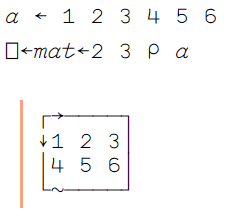Ok - I will take a stab at a PR with a processor to remove this bit of metadata. I’ll also try to test if it remembers state without the metadata.
That seems to be referring to the hidden state of the whole ToC.
ToC does remember state even if I remove the hidden metadata stuff. I am starting to look at a code to work on a PR.
I think this metadata should be stripped as a default. I think that it’d be more intuitive to strip it always since users can hide cells with directives. If a more advanced user wants to use that metadata for something, then I think better to put the burden on them to make the change than newer users.
Thoughts?
Yes I think so too. If you add it as a processor, it’s easy enough to turn on/off.
So I’m catching up and just starting on my APL journey today.
Right out of the blocks, I like this quote at the top of Learning APL
A language that doesn’t affect the way you think about programming is not worth knowing. –Alan Perlis
I promote the same thing about Smalltalk – my favourite language. Although far from mainstream, the pureness of its OO system changes how you think about OO. Sometime in the future I’d love an opportunity to lead a similar study group using Pharo. But I’ve been too comfortable for too long using mostly Pharo, so I’ll focus on just APL for a while, and thanks Jeremy for this opportunity to stretch myself.
Right now, in my pre-start vision of my APL journey, I’m naively inspired to try introducing APL array features to Pharo, to facilitate DL from there. This includes a few ambitious ideas I’d like to experiment with (which may be tempered by my APL experience and time constraints):
- Interfacing Pharo to Vulkan compute engine for GPU matrix arithmetic
- Drive Vulkan from APL inside Pharo by porting ngn-apl
p.s. It might be an interesting exercise to work out what some of these APL snippets do…
Jeremy was running late. So, today’s session is cancelled.
Sorry about today - I was interviewing JJ Allaire and it was meant to be 1 hour, but it was so interesting we went for two hours! So let’s skip today.
Cool beans. It would give me few days to catch up with lectures and materials till next week.
FYI @bencoman I removed the " (but don’t do that - stretch your mind!)" you added re 0-based indexing. I kinda agree with you, but I know a lot of APL experts don’t, so I don’t think we should be making such a definitive statement on this issue in the wiki!
so I don’t think we should be making such a definitive statement on this issue in the wiki
Cool, and thanks for the background - good to learn something from the counter-edit.
Now rather than another post, I’ll slip this in here…
When starting a new language, its worthwhile to consider the ancient wisdom
on how one might Shoot Yourself In The Foot.
TL;DR - from recent context maybe skim at least: apl, lisp, logo, python, smalltalk.
Thanks @Ezno for fixing the hidden code issue.
I’ve also fixed some issues with the CSS and HTML, and we now have a real APL font on our website! ![]()

This video was very fun to watch in the sense that you dont need even a display to interact with a computer! or in this case a REPL!
The video descriptions on YouTube should include a link to that video’s forum thread.
Only Tuesday to Friday (Australia). Hope to see u tomorrow.
Done!
Not every empty cell is equal. ![]()
So, make sure to activate ]Boxing on -style=max before coding. Reference: Shape Reshape - APL Course

My keyboard layouts, including ones that use right-side Alt as APL shifting key. This key, also known as AltGr, is particularly well-suited as APL key for those that use US or similar layouts, as the key has little or no usage.
I have a question, how are monadic and dyadic operations “defined” or chosed the way they are?
For example for +0j4 is different than the dyadic 0j4+0j4 but how some one said that monadic + is congujate?
I mean for - is pretty easy, but I think for others is more like a definition?
I guess it depends on each individual glyph. e.g. for monadic +, conjugate seems like a good choice, since - flips the sign of the real part of a number… so you’d want a similar glyph to represent flipping the imaginary part of a number. And + is very similar glyph conceptually to -.
In the end though, yes, it’s the decision of Ken Iverson (and those that have followed in his footsteps) as to what each glyph should mean. There’s some etymology here:
Now that you said conceptually similar I think I get why it flips the imaginary part…
So - flips in the real axes the number thus flipping its sign… so + flips the imaginary part along imaginary axes… thinking that way makes perfect sense… I guess will keep asking for “weird choices” which probably I will not get at first.
Guess it is not “matematically based” but makes sense.
Great!
